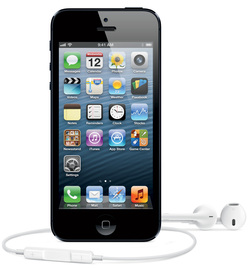
People today can now record videos, take pictures, send media, phone, text, tweet, Skype and blog all from one device. This convergence of technology has also made of these actions mobile as well. No longer do people need to be hardwired to dial-up Internet. Now, people can send messages whether they are in their backyard or sitting in the park. Mlot (2013) explains by the end of 2013 an estimated 1.82 billion smartphones are expected to be in use. In addition to smartphone, other mobile devices are frequently used. Here is an infographic that highlights the iPad:
So what does this mean for education, and how can mobile technology be utilized in the classroom?
Much of the current education system is still based on the idea of the industrial model. However, the means by which students can learn has changed dramatically during the century, but the education system itself hasn't followed suit as quickly. In terms of content, efforts are being made to educate students more about technology. However, I think more emphasis needs to be placed on including real-world content into the curriculum in order to engage students, and prepare them for life after graduation. The way in which this content is delivered is also important.
The methods and practices of the current education system needs to be more complimentary with respect to technology. Students today use Mobile Internet Devices (MIDs) more than any other generation in history. Therefore, why not embrace this, and use it to further learning? Nielsen (2013) points out that using mobile technology in the classroom can inspire and engage students by letting them lead their learning and supporting them in choosing and using the devices they know, love, and prefer ("Finally! Research-based proof that students use cell phones for LEARNING"). If students are more comfortable reading from a computer screen rather than a textbook then why not utilize that technology? However, there are things to consider at both the classroom and administration level?
For example, issues surrounding acceptable use need to be addressed. MIDs have the potential to be used for watching videos or playing games. Therefore, it is important to consider that students may not always be on task. Furthermore, there are issues concerning equal access to technology. Students from lower socio-economic statues may not have the ability to purchase a smartphone, and their education should not be compromised because of it. However, this can be mitigated by having a class set of iPads or having students share devices.
MIDs can strengthen learning in a variety of ways. Wylie (2013) argues that MID can make learning more flexible, they are easy to use, provide access to education apps, enrich learning, and engage and motivate students. However, it is important for teachers to introduce these devices into the classroom within an educational framework. THIS ARTICLE by Monica Burns offers different ways that mobile technology can be introduced into the classroom. If teachers demonstrate ways that they can be used to further learning, and explain that within the classroom education is the goal, then I think they can be great tools.
The ways in which MIDs are applied to edcuation can change the nature of learning in a number of ways. For instance, they can be used by students to create and present projects, as well as research information. They can also be a way for students to communicate with teachers, rather than face-to-face conversations.
Overall, the implications of MID are vast. Learning at any place and any time means that the boundaries of the classroom are virtually extinguished. Education is an ongoing process, and MIDs help to perpetuate this notion. Now, learning can happen at any time, virtually anywhere. I think this may blur the lines between formal and informal education. However, I believe any time and place learning is a positive trend because it promotes education and literacy, and opens many doors to knowledge.
References
Fig. 1. iphone5.jpg. Retrieved on July 19, 2013. From http://0.tqn.com/d/ipod/1/0/P/O/-/-/iphone-5.jpg
Fig. 2. ipad_infographic.jpg. Retrieved on July 19, 2013. From http://dailyinfographic.com/wp-content/uploads/2012/03/ipad_infographic.jpg
Burns, Monica. (2013, April 10). "Introducing Mobile Technology into Your Classroom: Structures and Routines." Retrieved from http://www.edutopia.org/blog/introducing-mobile-tech-structures-routines-monica-burns
Mlot, Stephanie. (2013, March 27). "Infographic: Mobile Devices Overtake Daily Life." Retrieved from http://www.pcmag.com/article2/0,2817,2416976,00.asp
Nielsen, Lisa. (2013, February 16). "Finally! Research-based proof that students use cell phones for LEARNING." Retrieved from http://theinnovativeeducator.blogspot.ca/2013/02/finally-research-based-proof-that.html
Wylie, Johnathan. (2013). "Mobile Learning Technologies for 21st Century Classrooms."Retrieved from http://www.scholastic.com/browse/article.jsp?id=3754742
Significant Comments:
http://ed4764blog.weebly.com/1/post/2013/07/topis-10-convergence-and-mobility.html#comments
http://ed4764muirhead.weebly.com/1/post/2013/07/mobile-devices-in-the-classroom.html#comments

 RSS Feed
RSS Feed